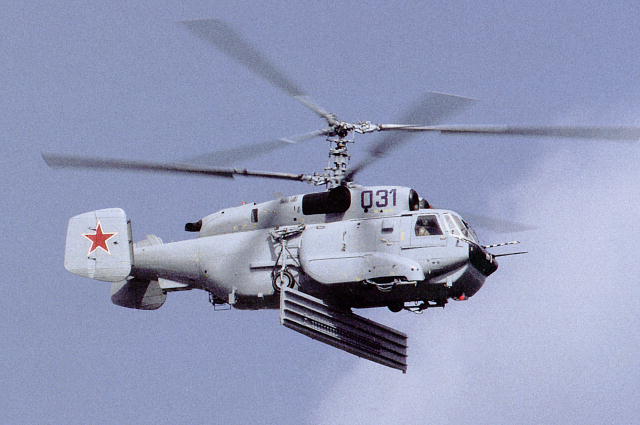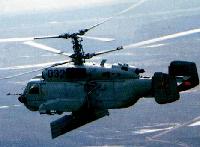
Варианты
- Камов - Ка-27 / Ка-28 - 1973 - Россия
- Камов - Ка-29 - 1976 - Россия
- Камов - Ка-32 - 1980 - Россия
- Камов - Ка-31 - 1987 - Россия
Ка-29 и Ка-31
<...>
На базе вертолетов Ка-27 и Ка-29 был создан принципиально новый образец вертолета корабельного базирования, не имеющий аналогов в мире, - вертолетный комплекс радиолокационного дозора и наблюдения Ка-31, оснащенный радиотехническим комплексом Э-801 с антенной РЛС кругового обзора, размещенной под фюзеляжем.
Работы над новой машиной, получившей вначале обозначение Ка-252РЛД, были начаты в ОКБ в 1985 году, первый полет опытная машина выполнила 25 ноября 1986 года, в 1995 году завершены госиспытания, а через три года в Кумертау было начато его серийное производство. Кроме ВМФ России, вертолет Ка-31 поставлялся ВМС Индии и Китая. На базе корабельного вертолета радиолокационного дозора и наблюдения разработан и с 2004 года проходит испытания армейский вариант аналогичного назначения.
Отличительными особенностями Ка-31 являются частично убирающееся шасси (передние опоры убираются назад по полету, а основные опоры поджимаются вверх, как на Ка-25Ц), передние опоры которого размещаются в левом и правом обтекателях, два боковых топливных бака и, самое главное, РЛС кругового обзора с фазированной антенной решеткой, убирающаяся в нерабочем положении под фюзеляж. Кабина - расширена на 500 мм, как у Ка-29, также на 500 мм увеличен поперечный размер части фюзеляжа, расположенной между шпангоутом стыковки его с кабиной экипажа и усиленным шпангоутом крепления основных опор шасси. Для размещения радиотехнического комплекса была частично переделана нижняя часть фюзеляжа, доработке подверглись силовая установка, топливная система и др.
Радиотехнический комплекс Э-801 способен в автоматическом режиме осуществлять обнаружение и опознавание воздушных и морских целей, определять параметры их движения и передавать эти данные в реальном масштабе времени на наземные или корабельные пункты управления. Пилотажно-навигационное оборудование вертолета позволяет ему выполнять автоматизированный полет по заданному маршруту.
- Описание
Фотографии
-
Jane's All the World Aircraft 2000 / 2-06 - AIRCRAFT - ROTARY-WING - MILITARY
Первый прототип Ка-31
Kamov Ka-31 radar picket helicopter with antenna deployed and landing gear retracted (1998) -
Air International 1999-05 / P.Butowski - Kamovs for the Navy /Military aviation/
This view of a Ka-31 shows the Oko radar antenna in its operating position
-
Air International 1999-05 / P.Butowski - Kamovs for the Navy /Military aviation/
This view of a Ka-31 shows the Oko radar antenna is stowed in its cruising position.
Другие самолёты на фотографии: Камов Ка-31 - Россия - 1987
-
Air International 2021-10 / A.Mladenov - Eye in the sky
The second Ka-31 serialled Red 032, is seen here during its flight trials by Kamov in the early 2000s, with the radar antenna deployed and rotating
-
Air International 2021-10 / A.Mladenov - Eye in the sky
The Ka-31 AEW helicopter programme survived in the late 1990s and early 2000s thanks to export orders by India and China. The production line at the KumAPE is set to be reactivated after an expected new order from India
-
Авиация и Космонавтика 2013-12
Ка-31 - развитие темы "вертолета радиолокационного дозора Ка-252РЛД"
-
Мировая Авиация 168
Ка-31 ("Helix-B") - корабельный вертолет радиолокационного дозора, созданный на базе вертолетов Ка-27 и Ка-29, оснащен двумя двигателями ТВ3-117ВМАР мощностью 2200 л.с. и радиотехническим комплексом Э-801 "Око" с антенной РЛС кругового обзора, размещенной под фюзеляжем. Комплекс Э-801 позволяет обнаруживать и брать на автосопровождение 20 целей типа "истребитель" на расстоянии 100-150 км, а целей типа "катер" - на дальности 250-285 км, передавая данные на наземные и корабельные пункты управления. В транспортном положении РЛС прилегает к нижней поверхности фюзеляжа, для перевода в рабочее положение антенна отклоняется вниз на 90°, а стойки шасси приподнимаются вверх, чтобы не мешать работе РЛС. Первый полет прототипа - Ка-252РЛД - состоялся 25 ноября 1986 года; построены две опытные машины, а с 1998 года в Кумертау начато серийное производство Ка-31. В 2002-2004 годах 9 вертолетов поставлены в Индию, в 2010 году начаты поставки 9 машин в КНР. С 2004 года идут испытания созданного на базе морского Ка-31 армейского вертолета радиолокационного дозора.
-
Авиация и Время 2012-06 / А.Хаустов - Мне сверху видно все...
Второй опытный экземпляр Ка-31 в ходе испытаний. Вторая половина 1980-х гг.
-
Air International 2018-09 / Airscene
Radar-equipped Ka-31R 90 and Ka-27M 39, headed this year's air parade over Saint Petersburg on July 29, 2018. Ka-31R 90 is one of two (the other is 91) acquired by Russian Naval Aviation in 2012. Twelve such helicopters were listed for procurement in Russia's National Armament Program through to 2020 for basing at Severomorsk-1 (Northern Fleet) and Nikolayevka (Pacific Fleet). However, no information has been released on any further order. Ka-31R 90 was deployed to Syria on board the Admiral Kuznetsov aircraft carrier between October 2016 and January 2017.
Другие самолёты на фотографии: Камов Ка-27 / Ка-28 - Россия - 1973
-
Авиация и Космонавтика 2021-09 / Д.Пичугин, Д.Попов - Главный Военно-морской парад 2021
Другие самолёты на фотографии: Камов Ка-27 / Ка-28 - Россия - 1973
-
Авиация и Время 2012-06 / А.Хаустов - Мне сверху видно все...
Опытный вертолет "23Д2". Зима 2009 г.
-
Air International 2015-08 / P.Butowski - Katran & Helix /Military/
This Ka-31R ‘91’ was the second example of this version to be delivered. Its permanent base will be the Severomorsk-1 airfield.
-
Air International 2020-05 / P.Butowski - Russian Review
Ka-31 serial 561 was the first example for the Indian Navy’s INAS 339 'Falcons' at Goa.
-
Авиация и Время 2012-06 / А.Хаустов - Мне сверху видно все...
Ка-31 перед передачей в состав ВМС Индии. Апрель 2003 г.
-
Air International 2015-06 / News
One of two refurbished Indian Navy Ka-31s, (IN-)583, is loaded onto Aviacon Zitotrans Ilyushin Il-76TD RA-78765 on April 22, 2015 for airfreighting back to India. Six of the Ka-31s supplied to India by the Kumertau Aviation Production Enterprise in 2004 were returned to the company for repairs and the remaining four are expected to be re-delivered shortly. A further three did not require refurbishment.
Другие самолёты на фотографии: Ильюшин Ил-76 - Россия - 1971
-
Air International 2020-05 / P.Butowski - Russian Review
Indian Navy Ka-31 serial 565 with the antenna of the E-801E Oko (eye) radar deployed.
-
Air International 2011-04 / P.Singh - Indian Naval White Tigers turn 50 /Military/
A Kamov Ka-31 airborne early warning helicopter of INAS 339 approaches the INS Viraat.
Другие самолёты на фотографии: BAe Sea Harrier - Великобритания - 1978
-
Авиация и Время 2012-06 / А.Хаустов - Мне сверху видно все...
Ка-31 авиации ВМС КНР. 2011 г.
-
Air International 1999-05 / P.Butowski - Kamovs for the Navy /Military aviation/
Другие самолёты на фотографии: Камов Ка-31 - Россия - 1987
-
Air International 2011-03 / News
This anonymous looking Kamov Ka-31 was seen flying near Kumertau, Russia on February 8, 2011. It is believed to be the fourth for the PLAN.
The large radar antenna of the Oko system is stowed under the helicopter’s belly when not in use and when deployed in flight, the antenna rotates at a rate of 6rpm -
Air International 2021-08 / A.Mladenov - Power struggle
The Ka-31 airborne radar surveillance and over-the-horizon targeting shipborne helicopter comes powered by the TV3-117VMAR engine with OEI rating of 2,400shp, while the take-off rating is set at 2,200shp
-
Air International 2021-10 / A.Mladenov - Eye in the sky
The Ka-31 is also offered as a tactical AEW platform for army and air force use. In this new guise, it was touted as being well suited for battlefield surveillance to detect and track low-flying fixed- and rotary-wing aircraft as well as cruise missiles
-
Air International 2021-10 / A.Mladenov - Eye in the sky
Kamov promoted the Ka-31 in the early and mid-2000s for the homeland security role in Russia and abroad. The firm's then Designer General, Sergey Mikheev, was keen to highlight its valuable peacetime potential in continuous monitoring of air, sea and land borders, sea economic zones and air traffic control and co-ordination of SAR operations in large-scale natural or industrial emergencies
-
Air International 2021-10 / A.Mladenov - Eye in the sky
A Ka-31 for the Chinese Navy seen in final assembly in the KumAPE plant in Kumertau, Russia, in February 2011
-
Air International 2021-08 / A.Mladenov - Power struggle
These TV3-117VMAR engines are shown ready for installation on a Ka-31 helicopter built at the KumAPE plant in Kumertau, Russia, and later exported to China in 2011
-
Air International 2021-10 / A.Mladenov - Eye in the sky
This is the Ka-31 ’s third engine, the TA-8K APU, which is used for continuous power supply in flight for the helicopter’s mission suite
-
Авиация и Время 2012-06 / А.Хаустов - Мне сверху видно все...
Вертолетный комплекс радиолокационного дозора Ка-31
-
Авиация и Время 2012-06 / А.Хаустов - Мне сверху видно все...
Второй прототип Ка-31
-
Авиация и Время 2012-06 / А.Хаустов - Мне сверху видно все...
Новейший российский Ка-31Р. Лето 2012 г.
-
Авиация и Время 2012-06 / А.Хаустов - Мне сверху видно все...
Выкатка из ангара индийского Ка-31. 10 февраля 2006 г.
-
Авиация и Время 2012-06 / А.Хаустов - Мне сверху видно все...
Левая основная и левая передняя опоры шасси
-
Авиация и Время 2012-06 / А.Хаустов - Мне сверху видно все...
Вспомогательная силовая установка ТА8К
-
Авиация и Время 2012-06 / А.Хаустов - Мне сверху видно все...
Опорно-поворотное устройство антенны РЛС
-
Авиация и Время 2012-06 / А.Хаустов - Мне сверху видно все...
Сборка Ка-31 на КумАПП
-
Air International 1999-05 / P.Butowski - Kamovs for the Navy /Military aviation/
Cockpits of the three basic Helix variants have almost identical instrumentation and controls for the pilot (left hand seat). The right hand stations are configured to suit specific versions: Early warning Ka-31. System operator has only a modest display because target data is transmitted directly to the command centre on the ship and is not processed on board the helicopter.
-
Air International 2021-10 / A.Mladenov - Eye in the sky
The Ka-31’s crew consists of a pilot and a navigator-operator who occupy the left- and right-hand seats respectively. The navigator-operator is responsible for operating the radar and datalink but does not have any control and command functions
-
Авиация и Время 2012-06 / А.Хаустов - Мне сверху видно все...
Кабина экипажа индийского Ка-31
-
Air International 2011-02 / News
No official image of the Ka-252SV (23D2) has been released, but this artist's impression shows the general arrangement and some significant points. These include the surveillance radar's 5.5m by 1m (18ft by 3.3ft) rotating aerial (1); the four antennas of the KSS-23 encoded data link (2); IR/UV missile approach warning system with four sensors at both sides of front and rear fuselage (3); electro-optical jammer (4), another of which is located beneath the rear fuselage; 50mm flare launcher (5); two 26mm flare launchers (6), with 3 to 6 being components of the L381 Vitebsk self defence system; main undercarriage legs (7) that rise above the antenna's sweep, the front units folding up.
-
Air International 1999-05 / P.Butowski - Kamovs for the Navy /Military aviation/
Kamov's shipborne helicopters, from the Ka-8 to the Ka-60.
Другие самолёты на фотографии: Камов Ка-10 - Россия - 1949Камов Ка-137 - Россия - 1998Камов Ка-15 - Россия - 1953Камов Ка-25 - Россия - 1961Камов Ка-25Ц - Россия - 1963Камов Ка-27 / Ка-28 - Россия - 1973Камов Ка-29 - Россия - 1976Камов Ка-40 - Россия - 1990Камов Ка-60 Касатка - Россия - 1998Камов Ка-8 - Россия - 1947
- Фотографии













































